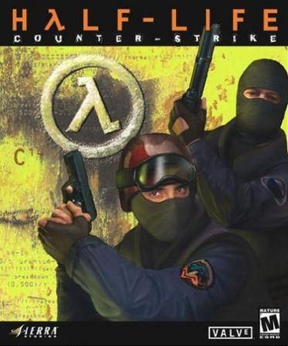
Counter-Strike is a tactical first-person shooter game developed by Valve. It was initially developed and released as a Half-Life modification by Minh "Gooseman" Le and Jess Cliffe in 1999, before Le and Cliffe were hired and the game's intellectual property acquired. Counter-Strike was released by Valve for Microsoft Windows in November 2000, and is the first installment in the Counter-Strike series. Several remakes and ports were released on Xbox, as well as OS X and Linux.

Valve Corporation, also known as Valve Software, is an American video game developer, publisher, and digital distribution company headquartered in Bellevue, Washington. It is the developer of the software distribution platform Steam and the game franchises Half-Life, Counter-Strike, Portal, Day of Defeat, Team Fortress, Left 4 Dead, and Dota.
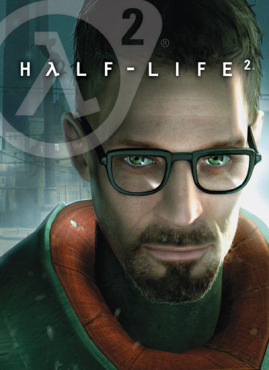
Half-Life 2 is a 2004 first-person shooter (FPS) game developed and published by Valve Corporation. It was published for Windows on Valve's digital distribution service, Steam. Like the original Half-Life (1998), Half-Life 2 combines shooting, puzzles, and storytelling, and adds new features such as vehicles and physics-based gameplay. The player controls Gordon Freeman, who joins a resistance to liberate Earth from the Combine, an interplanetary alien empire.
Source is a 3D game engine developed by Valve. It debuted as the successor to GoldSrc in 2004 with the releases of Half-Life: Source, Counter-Strike: Source, and Half-Life 2. It is most well-known for its usage by Valve, but the engine has been used both by small teams and individuals to create modifications of Valve games, and other studios creating distinct games, notably Troika Games' title Vampire: The Masquerade – Bloodlines. Valve continued to create incremental updates to the Source engine after its 2004 release, most of which coincided with games created by Valve. In the late 2010s, Valve created the Source 2 engine to replace Source, with it publicly debuting alongside Half-Life: Alyx. The Source engine is most well-known for its advancements in physics, AI, and graphics.

Steam is a video game digital distribution service and storefront developed by Valve Corporation. It was launched as a software client in September 2003 to provide game updates automatically for Valve's games, and expanded to distributing third-party titles in late 2005. Steam offers various features, like game server matchmaking with Valve Anti-Cheat measures, social networking, and game streaming services. Steam client's functions include game update automation, cloud storage for game progress, and community features such as direct messaging, in-game overlay functions and a virtual collectable marketplace.

Counter-Strike: Condition Zero is a first-person shooter video game developed by Ritual Entertainment, Turtle Rock Studios, and Valve, and published by Sierra Entertainment and Valve. The follow-up to Counter-Strike (2000), it was released in March 2004 for Windows. Condition Zero utilizes the GoldSrc engine and has a multiplayer mode, which features updated character models, textures, maps and other graphical tweaks. It also includes two single-player campaigns; Tour of Duty and Condition Zero: Deleted Scenes.

Valve Anti-Cheat (VAC) is an anti-cheat tool developed by Valve as a component of the Steam platform, first released with Counter-Strike in 2002.

Half-Life is a series of first-person shooter (FPS) games created by Valve. The games combine shooting combat, puzzles and storytelling.

Counter-Strike Online (CSO) is a tactical first-person shooter video game, targeted towards Asia's gaming market released in 2008. It is based on Counter-Strike and was developed by Nexon with oversight from license-holder Valve. It uses a micropayment model that is managed by a custom version of Steam.

GoldSrc, sometimes called the Half-LifeEngine, is a proprietary game engine developed by Valve. At its core, GoldSrc is a heavily modified version of id Software's Quake engine. It made its debut in 1998 with Half-Life and powered future games developed by or with oversight from Valve, including Half-Life's expansions, Day of Defeat and games in the Counter-Strike series.
Kelly Bailey is a Canadian-American composer, musician, programmer and sound designer. He was the senior game designer of sound and music at Valve until he left in 2011 with Mike Dussault to concentrate on their project, Sunspark Labs LLC. Valve composer Mike Morasky mentioned in February 2014 that Bailey had returned to Valve, but in a February 2016 article on Forbes it was reported that Bailey has founded his own company, IndiMo Labs, and that he is no longer with Valve.

Counter-Strike: Global Offensive (CS:GO) is a 2012 multiplayer tactical first-person shooter developed by Valve and Hidden Path Entertainment. It is the fourth game in the Counter-Strike series. Developed for over two years, Global Offensive was released for OS X, PlayStation 3, Windows, and Xbox 360 in August 2012, and for Linux in 2014.
Counter-Strike (CS) is a series of multiplayer tactical first-person shooter video games in which teams of terrorists battle to perpetrate an act of terror while counter-terrorists try to prevent it. The series began on Windows in 1999 with the release of the first game, Counter-Strike. It was initially released as a modification ("mod") for Half-Life that was designed by Minh "Gooseman" Le and Jess "Cliffe" Cliffe before the rights to the mod's intellectual property were acquired by Valve, the developers of Half-Life, who then turned Counter-Strike into a retail product released in 2000.
In video games, skin gambling is the use of virtual goods, often cosmetic in-game items such as "skins", as virtual currency to bet on the outcome of professional matches or on other games of chance. It is commonly associated with the community surrounding Counter-Strike 2, but the practice exists in other games such as Electronic Arts's FIFA. Valve, the developer of the Counter-Strike series, also runs the Steam marketplace which can be interfaced by third-parties to enable trading, buying, and selling of skins from players' Steam inventories for real-world or digital currency. Valve condemns the gambling practices as it violates the platform's terms of service.
The Counter-Strike match fixing scandal was a 2014 match fixing scandal in the North American professional scene of Counter-Strike: Global Offensive (CS:GO). It involved a match between two teams, iBUYPOWER and NetCodeGuides.com, where questionable and unsportsmanlike performance from the team iBUYPOWER, then considered the best North American team, drew suspicion, resulting in a loss for the team; allegations quickly surfaced afterwards that the match was fixed. More decisive evidence and punishments would come half a year later, after an expository article was published by esports journalist Richard Lewis.
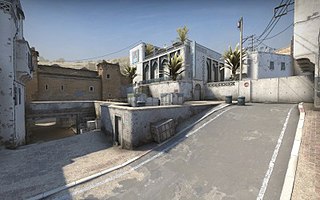
"Dust II", also known by its filename de_dust2, is a video game map featured in the first-person shooter series Counter-Strike. Dust II is the successor to "Dust", another Counter-Strike map, and was developed by David Johnston before the official release of the original Counter-Strike game. It was designed with the aims of simplicity and balance, based on its symmetrical design and two points, over which the two teams must fight for control.
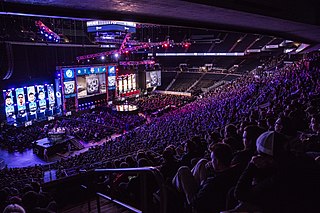
Professional Counter-Strike competition involves professional gamers competing in the first-person shooter game series Counter-Strike. The original game, released in 1999, is a mod developed by Minh "Gooseman" Le and Jess Cliffe of the 1998 video game Half-Life, published by Valve. Currently, the games that have been played competitively include Counter-Strike, Counter-Strike: Condition Zero (CS:CZ), Counter-Strike: Source (CS:S), Counter-Strike: Global Offensive (CS:GO), and Counter-Strike 2 (CS2). Major esports championships began in 2001 with the Cyberathlete Professional League Winter Championship, won by Ninjas in Pyjamas.
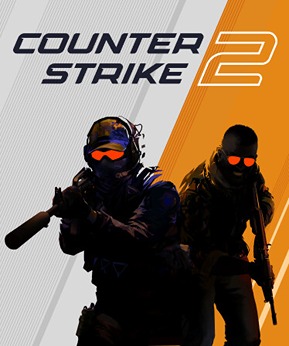
Counter-Strike 2 is a 2023 multiplayer tactical first-person shooter game developed and published by Valve. It is the fifth main installment of the Counter-Strike series. Developed as an updated version of the previous main entry, Counter-Strike: Global Offensive (2012), it was announced on March 22, 2023, and was released on September 27, 2023, for Windows and Linux, replacing Global Offensive on Steam.














